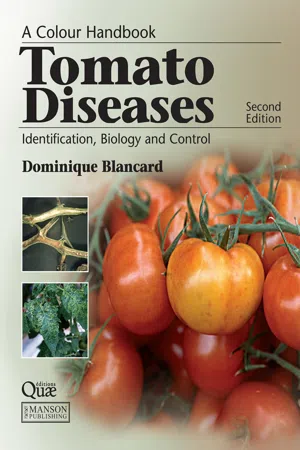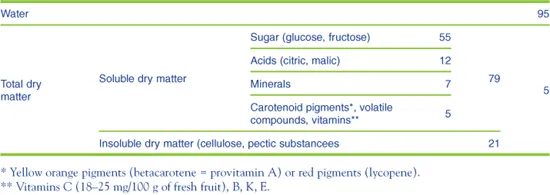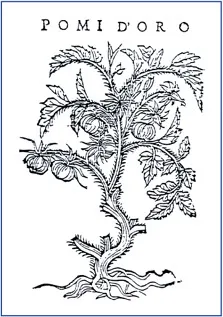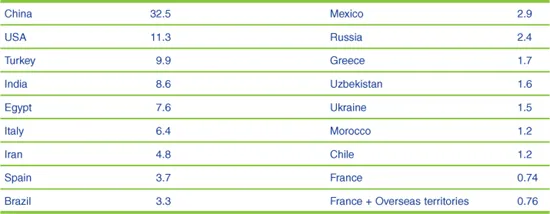
eBook - ePub
Tomato Diseases
Identification, Biology and Control: A Colour Handbook, Second Edition
This is a test
- 688 pages
- English
- ePUB (mobile friendly)
- Available on iOS & Android
eBook - ePub
Tomato Diseases
Identification, Biology and Control: A Colour Handbook, Second Edition
Book details
Book preview
Table of contents
Citations
About This Book
Following the successful first edition, this revised and greatly expanded edition Tomato Diseases: Identification, Biology and Control is the definitive work on the diseases and disorders of the tomato. The tomato is the world's most widely produced vegetable. The number of diseases affecting the tomato is enormous: hundreds of bio-aggressors, more
Frequently asked questions
At the moment all of our mobile-responsive ePub books are available to download via the app. Most of our PDFs are also available to download and we're working on making the final remaining ones downloadable now. Learn more here.
Both plans give you full access to the library and all of Perlego’s features. The only differences are the price and subscription period: With the annual plan you’ll save around 30% compared to 12 months on the monthly plan.
We are an online textbook subscription service, where you can get access to an entire online library for less than the price of a single book per month. With over 1 million books across 1000+ topics, we’ve got you covered! Learn more here.
Look out for the read-aloud symbol on your next book to see if you can listen to it. The read-aloud tool reads text aloud for you, highlighting the text as it is being read. You can pause it, speed it up and slow it down. Learn more here.
Yes, you can access Tomato Diseases by Dominique Blancard in PDF and/or ePUB format, as well as other popular books in Biological Sciences & Biology. We have over one million books available in our catalogue for you to explore.
Information
1
The tomato plant and its culture

Lycopersicon esculentum and related species1
• Origin, history of its expansion in the world
The tomato, unknown in the Old World until the sixteenth century and still very little used in the nineteenth century, became the star of the vegetables in the twentieth century, both in commercial cultivation and in home gardens. It is appreciated for its freshness and is the base or topping in all sorts of dishes, either raw or cooked. Its use in sauces is traditional, especially in Italy. The processing industry offers many different preparations: concentrate, juice, peeled tomatoes, crushed tomatoes, and so on. Because of its relatively high level of consumption, tomato accounts for a significant part in the intake of vitamins and minerals in the diet (Table 1).
Table 1 Chemical composition of tomato fruit (%)

The arrival of the tomato in the Old World
Originally from South America, the tomato was domesticated in Mexico. Its introduction in Spain and Italy, and from there, into other European countries, was in the first half of the sixteenth century (Figure 1). Originally, it was cultivated by the Aztecs; its name comes from ‘tomatl’ from the Nahuatl language spoken in the region of Mexico, and corresponds to Physalis philadelphica; the tomato itself, Lycopersicon esculentum, was called ‘jitomatl’.
The first mention of the tomato in the Old World is by the Italian botanist, Pietro Matthioli Andreas, in 1544. He described it as a species carrying “flattened and ribbed fruits, which go from green to golden yellow and which some consume fried in oil with salt and pepper, like eggplant and mushrooms”. A decade later, he mentions that there are yellow tomatoes and red tomatoes. The Italian name ‘pomodoro’ seems to confirm that the first tomatoes, at least those that arrived in Italy, produced yellow fruit. In the texts of the sixteenth and seventeenth centuries, tomato receives various names, including ‘mala aurea’, the Latin equivalent of ‘pomodoro.’ The name ‘pomme d’amour’ in French, with its equivalents ‘love apple’ in English, and ‘Liebesapfel’ in German, alludes to the aphrodisiac effect then attributed to this fruit.
1 In 2006 Peralta et al. proposed a revision of the nomenclature of species in the genus Lycopersicon (Peralta et al. 2006. Nomenclature for cultivated wild and tomatoes. TGC Report, 56:6–12), and some of the proposed changes are shown in Box 1. This revised classification is not unanimously accepted, so we have preferred to keep the old names of the different species of Lycopersicon that are discussed in this book.
In the Old World, the first graphical representations of the tomato are those of Rembertus Dodonaeus (Antwerp, 1553), Georg Oelinger (Nuremberg, 1553), again R. Dodonaeus (Antwerp, 1574, see Figure 2), and Castore Durante (Rome, 1585, see Figure 3). In this part of the world, the tomato was viewed with suspicion. It was believed to be toxic, like other species of the family Solanaceae to which the tomato belongs, such as belladonna, the nightshade, or mandrake, a plant with magical powers. For a time the tomato was cultivated as an ornamental curiosity and is still sometimes used to decorate balconies, after which its fruit is then eaten. It appears that its use in food developed first in the form of sauces to complement cooking. Tomato consumption in the form of fresh fruit started in the Mediterranean and spread northward in the late eighteenth century.

Figure 1 Map to show the possible expansion of the tomato crop worldwide.
Botanists have repeatedly altered the names of genus and species assigned to the tomato. In some earlier books, Solanum esculentum, S. lycopersicum, and Lycopersicon lycopersicum are used. The name finally selected until very recently (see Box 2), Lycopersicon esculentum Mill., was assigned by Philip Miller in 1754. The name of the genus Lycopersicon is Greco-Latin, and means ‘wolf-peach’. The species name ‘esculentum’ comes from Latin and means ‘edible’. This does not mean edible foliage, or young green fruit as they contain toxic alkaloids (tomatine, solanine). These disappear during fruit development.

Figure 2 Drawing of a tomato plant published in the book Purgantium aliarumque eo facietium historiae. libri III, Antwerp 1574, by Rembertus Dodonaeus, sometimes cited under the names ‘Dodoens’, ‘Dodonée’, or ‘Dodon’; physician and botanist to two Germanic emperors, born in Friesland (1517), and died in Mechelen (1585).

Figure 3 Drawing of tomato plants published in the book Herbario nuovo che con figure rappresentano the bright piante che in tutta Europa nascono and nell’Indie, etc., Rome 1585, Castor Durante; Italian physician and botanist, physician to Pope Sixtus V, born in Gualdo, died in Viterbo (1590).
• Economic importance
The tomato is, after the potato, the most consumed vegetable in the world, either fresh or after processing. It is grown in all latitudes in a variety of conditions (climate, production, Photos 1–5), demonstrating useful variability and demonstrating the effectiveness of the work done by plant breeders.
World production of tomatoes has increased steadily during the twentieth century and has grown considerably over the past three decades. It rose from 48 million tonnes in 1978 to 74 million in 1992, 89 million in 1998, and reached 124 million in 2006. Among the 16 countries that produced 1 million tonnes or more, six are well above 5 million tonnes (Table 2). An estimated 30% of tomatoes produced are processed, but this percentage varies from one country to another.
Consumption of tomatoes per individual, whether fresh or processed, is increasing worldwide. The Mediterranean countries are large consumers, at all times of the year. In France, consumption of fresh tomatoes is around 13 kg/person/year, while the consumption in the form of processed products is reaching the equivalent of 22 kg of fresh tomato. These figures, from the Centre Technique Interprofessionnel des fruits et légumes (CTIFL), are based on domestic production, incorporating imports and exports. It is likely that demand in tomatoes will continue to grow, due to the human population increase, the shelf life that allows long-distance transport, the diversification of variety types, and the dietary changes that guide consumers towards products such as this vegetable.
Table 2 Production of tomatoes in 2006 (in million tonnes, FAO, 2007)

• Lycopersicon esculentum: the species and its biology
The cultivated tomato, Lycopersicon esculentum, belongs to the Solanaceae family. It is a diploid species with 2n = 24 chromosomes, among which there are many single-gene mutants, some being very important for selection.

Figure 4 The main aerial parts of a tomato plant.
Two growth patterns
The variety ‘Marglobe’, taken as a reference by breeders, has a morphology representative of cultivated varieties, with only one stem and indeterminate growth pattern. After germination and emergence of two cotyledons, the stem grows and six to nine alternate leaves are produced before the onset of an inflorescence producing five to 12 flowers. Subsequently, three new leaves will form before a new inflorescence. Growth continues in series (sympodially) of three leaves and one inflorescence. This is called sympodial growth.
Side shoots grow from the axils of each leaf. These are also of indeterminate growth. In single-stem culture, ...
Table of contents
- Cover Page
- Tomato Diseases
- Copyright Page
- CONTENTS
- FOREWORD
- ACKNOWLEDGEMENTS
- INTRODUCTION
- HOW TO USE THIS BOOK
- 1 The tomato plant and its culture
- 2 Diagnosis of parasitic and nonparasitic diseases
- 3 Principal characteristics of pathogenic agents and methods of control
- 4 Resistance to diseases and pests in tomato
- GLOSSARY
- MAIN WORKS OF REFERENCE
- INDEX